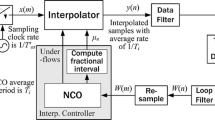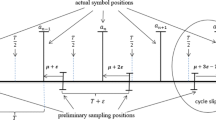Abstract
The evolving digital television broadcasting standard does not standardize the data rate 1/T of the transmitted data but instead leaves it completely unspecified. We propose two digital receiver algorithms based on a free running oscillator (rate 1/Ts) for the processing of an extended range of variable sample rates Ts/T based on a timing synchronization algorithm producing synchronized samples at rate M/T where M is variable. It is shown that the well known timing error detector from Gardner[1] also works for M>2 which forms the basis of the timing synchronizer which is built similar to [2, 3]. Main issue for variable symbol rate receivers is to supress aliasing due to the different sampling rates in the receiver. One of the algorithms removes aliasing by filtering the received samples prior to timing synchronization and choosing M=2, whereas the second algorithm also uses the sample rate 3/T in the timing recovery loop and matched filter depending on T/Ts and thus avoids the necessity of prefiltering. The algorithms are compared in terms of their complexity, timing error variance and BER performance. Both algorithms can be implemented causing negligible loss in a DVB receiver.
Similar content being viewed by others
References
F. Gardner, “A BPSK/QPSK Timing-Error Detector for Sampled Receivers,” IEEE Transactions on Communications, Vol. COM-34, pp. 423–429, May 1986.
L. Erup, “Simulation of Interpolators and Their Control,” in Proceedings of the IEEE CAMAD3, IEEE, 1990.
F. M. Gardner and L. Erup, “Interpolation in Digital Modems-Part i,” IEEE Transactions on Communications, Vol. 41, no.3, pp. 501–507, 1993.
G. Karam, K. Maalej, V. Paxal, and H. Sari, “Variable Symbol-Rate Modem Design for Cable and Satellite Broadcasting,” in M. Luise and E. Bighlieri (eds.), Proc. 7th International Tirrhenian Workshop on Digital Communications, London, Springer, 1996.
H. Meyr, M. Oerder, A. Polydoros, “On Sampling Rate, Analog Prefiltering and Sufficient Statistics for Digital Receivers,” IEEE Transactions on Communications, 1994.
M. Oerder and H. Meyr, “Derivation of Gardner's timing error detector from the maximum likelihood principle,” IEEE Transactions on Communications, Vol. COM-35, pp. 684–685, June 1987.
H. Meyr et al., Synchronization in Digital Communications, Vol. 2. John Wiley & Sons, 1997.
T. I. Laakso, V. Välimäki, M. Karjalainen, and U. Laine, “Splitting the Unit Delay,” EEE Signal Processing Magazine, pp. 30–60, January 1996.
The MathWorks, MATLAB Reference Guide. Cochituate Place, 24 Prime Park Way, Natick, Mass. 01760, 1994. Documentation of MATLAB 4.2.
L. Scharf, Statistical Signal Processing. Addison Wesley, 1993.
M. Moeneclaey, “A simple lower bound on the linearized performance of practical symbol synchronizers.,” IEEE Transactions on Communications, Vol. COM-31, pp. 1029–1032, 1983.
M. Moeneclaey, “A fundamental lower bound on the performance of joint carrier and bit synchronizers,” IEEE Transactions on Communications, Vol. COM-32, pp. 1007–1012, 1984.
Synopsys, Mountain View, CA, COSSAP stream driven simulator user guide, version 6.7, 1994.
European Telecommunications Institute, “Digital Broadcasting System for Television, Sound and Data Services; Framing Structure, Channel Coding and Modulation for 11/12 GHz Satellite Services,” Tech. Rep. DE/JTCDVB6, ETSI Secretariat, 06921 Sophia Antipolis - France, August 1995.
Y. Yasuda, “High-Rate Punctured Convolutional Codes for Soft Decision Viterbi Decoding,” IEEE Transactions on Communications, Vol. COM-32, March 1984.
J. P. Odenwalder, Optimum Decoding of Convolutional Codes. PhD thesis, University of Califiornia, Los Angeles, 1970.
I. Gradshteyn and I. Ryzhik, Table of Integrals, Series and Products. Academic Press, Corrected and enlarged Edition, 1980.
Author information
Authors and Affiliations
Rights and permissions
About this article
Cite this article
Lambrette, U., Langhammer, K. & Meyr, H. An Aliasing-Free Receiver with Variable Sample Rate Digital Feedback M/T NDA Timing Synchronization. Wireless Personal Communications 8, 165–183 (1998). https://doi.org/10.1023/A:1008807410397
Issue Date:
DOI: https://doi.org/10.1023/A:1008807410397




